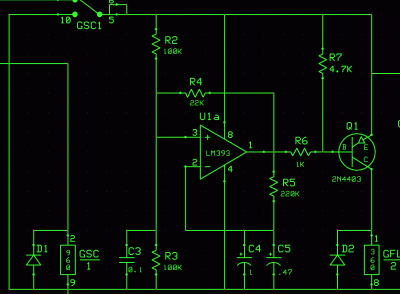joanlluch wrote:
- I want the slow source to be variable along the few Hz range (maybe up to 10 Hz or so), so I think the 555 timer circuit described in the "digital computer electronics" book should do it.
A problem with using a 555 timer, as previously mentioned, is the output transition time is much too slow for the 65C02. Also, you need to try for 50/50 symmetry, which is hard to attain from a relaxation oscillator.
Something I use in some of my designs that require a slow but stable symmetric "tick" is a comparator oscillator, such as the below illustration.
Attachment:
File comment: Comparator Oscillator Illustration
 comparator_oscillator_application.gif [ 19.63 KiB | Viewed 1333 times ]
comparator_oscillator_application.gif [ 19.63 KiB | Viewed 1333 times ]
This particular application is a model railroad grade crossing signal flasher, with the comparator oscillator cycling the signal lights at the rate of 1 Hz. The circuit has near-perfect symmetry and is relatively insensitive to Vcc.
The circuit works because the input transition threshold of a comparator is extremely narrow, at most a few millivolts. Hence the oscillation frequency is a function of the R-C time constant of R5 and the C4/C5 combination. R5 is both charge and discharge path for the capacitors, which means symmetry is as good as that of the comparator "crossover" characteristics. The ratio between R4 and R5 is not critical, so you could use a pot in place of R5 to create a low-speed variable clock.
The comparator's output is an open collector, so it has to be pulled up to Vcc—anything from 1K to 4.7K is usually sufficient. Open collector outputs are somewhat on the slow side, relatively speaking, with a high-to-low transition typically around 1 µs. A Schmidt trigger, such as a 74AC14, should be used to condition the oscillator's output so as to satisfy the 65C02's Ø2 clock requirements.







